White animals come in all shapes and sizes. These beautiful creatures often stand out from the crowd. Depending on their habitat, this unique color choice can have a positive or negative impact on their survival rates. Also, the reason behind the striking color varies from creature to creature.
I’ve pulled together a list of animals that are white. Plus, I’ll share more information about each white animal.
Key facts:
- White animals might be naturally white. Or they could be white based on a genetic condition, like leucistic and albino animals.
- Popular white animals include polar bears, great egrets, white tigers, and beluga whales.
List of 25 White Animals
Here’s a quick summary of white animals:
- Polar Bear
- Snowy Egret
- Arctic Hare
- Great Egret
- Cattle Egret
- Arctic Wolf
- White Tiger
- Ermine
- Arctic Fox
- Beluga Whale
- Silkie Chicken
- White-Tailed Ptarmigan
- White Dove
- Swan
- White Ravens
- Kermode Bears
- Albino Alligators
- Camargue Horse
- Dall’s Sheep
- Snowy Owl
- Harp Seal Pup
- White Tern
- Ivory Gull
- Snow Petrels
- White Pelicans
White vs. Leucistic vs. Albino
When it comes to white animals, the reason for their color can vary. Some species are naturally adapted to be white. Other animals are white due to a genetic issue, as is the case in leucistic and albino animals.
Below is a look at the different reasons why an animal might be white:
- White animals: White animals typically exhibit a coat or fur coloration that lacks pigmentation, resulting in a pure white appearance. This lack of coloration can be due to specific breed characteristics or seasonal shifts.
- Leucistic animals: Leucism is a condition characterized by partial loss of pigmentation in animals, leading to a lighter-than-normal coloration. Unlike albinism, leucistic animals may retain some pigmented features, such as colored eyes or patterns on the skin. Leucism is caused by a reduction in various pigments, not just melanin, and can affect a variety of species.
- Albino animals: Albinism is a genetic condition resulting in a complete absence of melanin, the pigment responsible for coloration in skin, hair, and eyes. Albino animals often have a strikingly pale appearance, with white or pinkish skin, fur, and red or pink eyes due to the lack of melanin in the irises. Albinism can affect a range of species, and individuals with this condition may face increased sensitivity to sunlight and vision impairments.
Implications For White Animals
Animals that are naturally adapted to be white are often perfectly suited for their environment. For example, an arctic hare’s white coat helps it blend into the environment during the winter months. But albino and leucistic animals often encounter unique challenges in their natural environments due to their distinctive colorations.
One significant issue faced by these individuals is increased vulnerability to predation. The lack of camouflage resulting from their pale coloration makes them more conspicuous targets for predators, compromising their ability to blend into their surroundings for protection. Additionally, albino animals, in particular, may experience heightened sensitivity to sunlight, as their lack of melanin fails to provide adequate protection against harmful UV rays. This can lead to sunburns, skin issues, and even vision impairments, further exacerbating their vulnerability in the wild.
Another challenge stems from potential social ostracism within their own species. In some animal communities, individuals with abnormal colorations may be shunned or treated differently by their peers. This exclusion can impact their ability to form social bonds, find mates, and engage in normal reproductive behaviors.
25 White Animals
Ready to learn more about the white animals included on our list? Dive into the details below.
Polar Bear
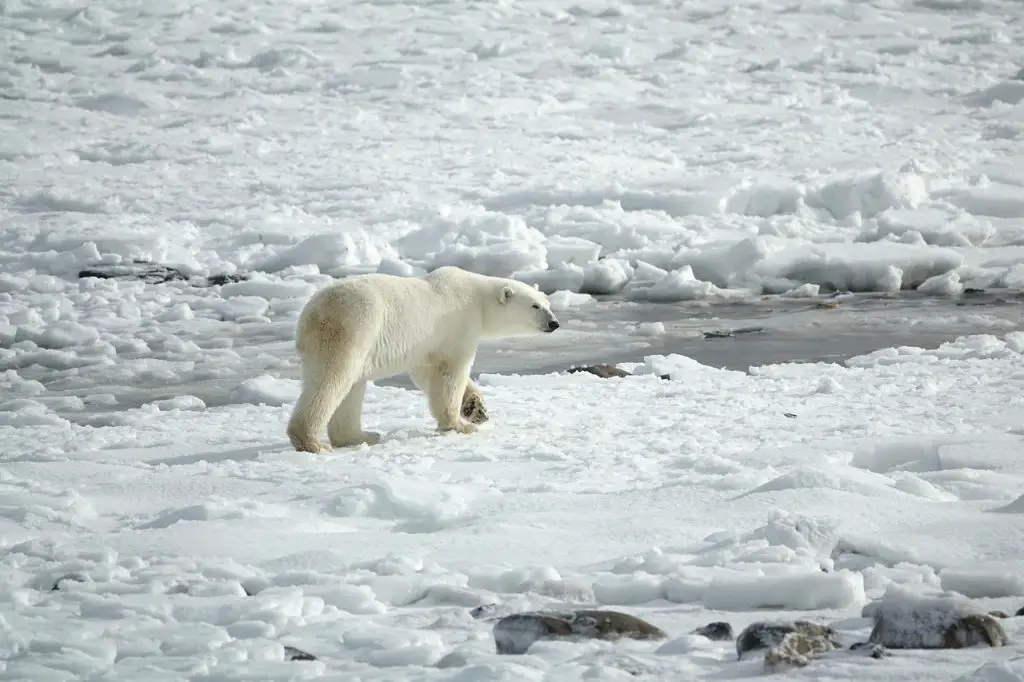
The polar bear (Ursus maritimus) stands as an icon of the Arctic, perfectly adapted to its frigid surroundings. These formidable creatures boast a pristine white coat that serves as both a mesmerizing visual spectacle and a strategic survival tool. The seemingly bleach-white fur is not, in fact, pigmentless but rather composed of translucent hollow hairs that scatter and reflect light, providing the bears with their characteristic snowy appearance. This natural camouflage aids in their stealthy approach during hunts on the sea ice, allowing them to blend seamlessly with their icy habitat as they stalk seals, a primary prey.
Polar bears are colossal carnivores, with males weighing up to 1,500 pounds or more. And these giants are exceptional swimmers who can cover vast distances in search of prey.
Snowy Egret
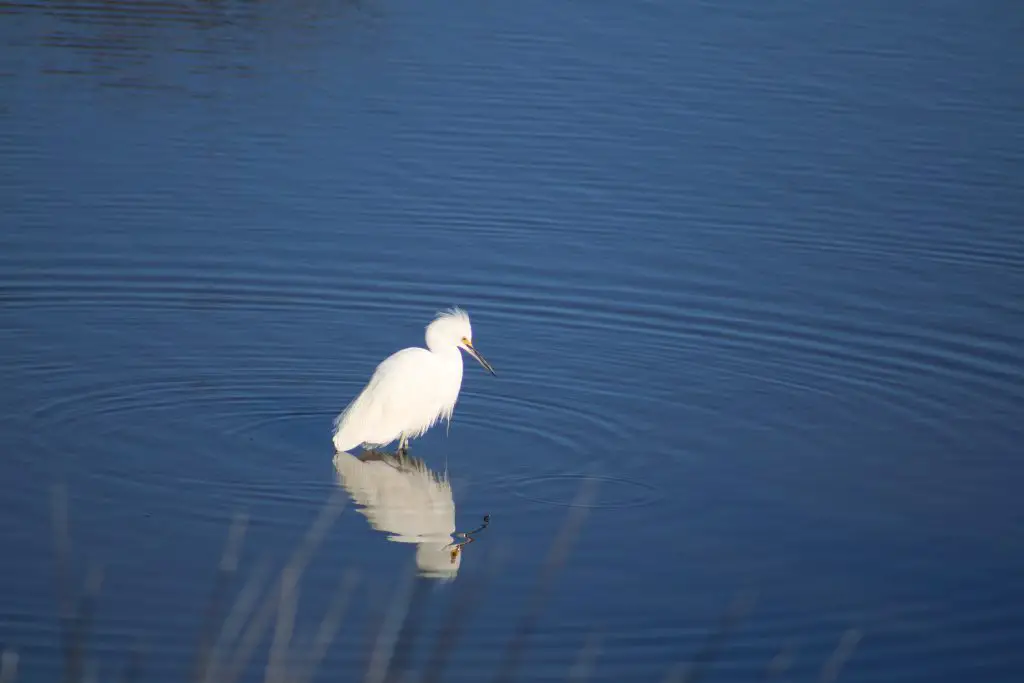
The snowy egret (Egretta thula) graces wetlands and coastal areas with its striking white plumage. You can spot them looking for prey in shallow water. When prey is scare, they might resort to canopy feeding, which involves shading the water with their wings. Fish tend to like shady spots, which means the egret has set the perfect trap for a tasty meal.
Arctic Hare
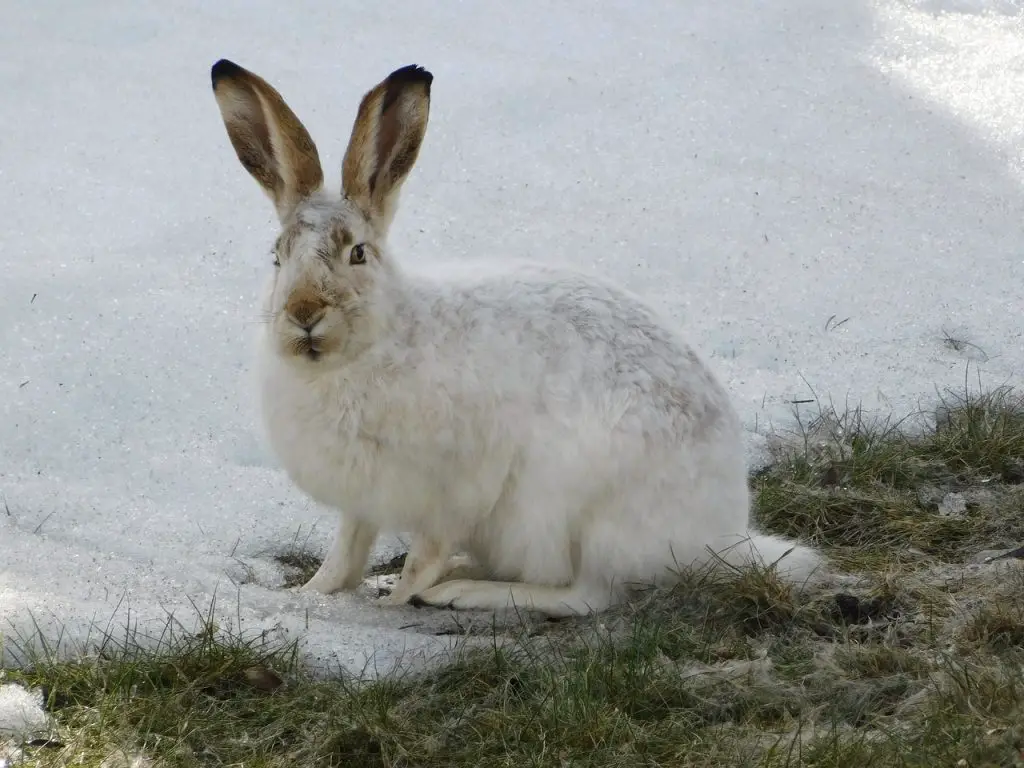
The Arctic hare (Lepus arcticus) stands out as a resilient inhabitant of the polar regions, adapted to the harsh conditions of the Arctic tundra. Its distinctive white fur serves as a vital adaptation to the extreme environment, providing camouflage against the snowy landscapes and offering protection from predators such as Arctic foxes and birds of prey. During the winter, their coat transforms to a brilliant white, while in the summer, it transitions to a more subdued grayish-brown, aiding in seasonal camouflage.
When on the run from a predator, arctic hares can reach speeds of up to 40 miles per hour.
Great Egret
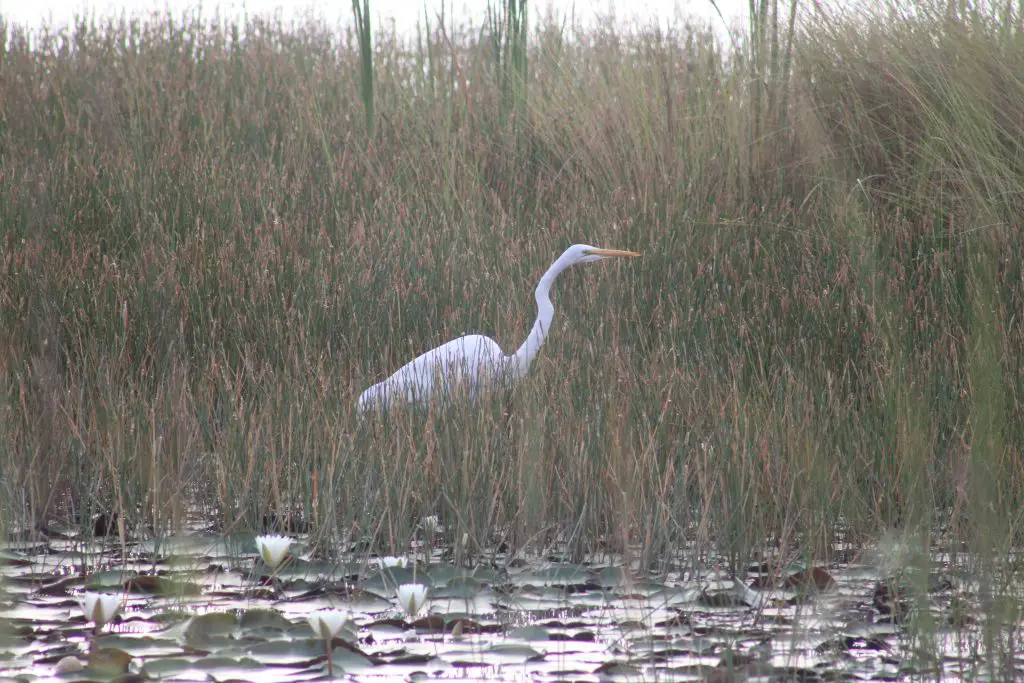
The great egret (Ardea alba) adorns wetlands and marshes. The wading bird relies on its white coloration as a strategic advantage in its hunting endeavors. The radiant white feathers not only contribute to its regal appearance but also serve as effective camouflage against the aquatic habitats where it patiently stalks fish, frogs, and other prey.
Great egrets have elaborate courtship displays, where these birds engage in intricate feather displays and sky-pointing behaviors to establish bonds during the breeding season. Despite their captivating presence, great egrets faced severe threats in the past due to the demand for their plumes in the fashion industry, leading to a decline in their populations. Conservation efforts, including legal protections and habitat restoration, have contributed to their recovery.
Cattle Egret
The cattle egret (Bubulcus ibis) often lives in close association with grazing livestock. As livestock move around, they disturb bugs. And the cattle egret swoops in to feast on the moving insects.
Physically, the cattle egret is a relatively small bird with a stocky build, measuring around 20 inches in length. During the breeding season, they develop striking orange-buff plumes on their head, neck, and back.
Arctic Wolf
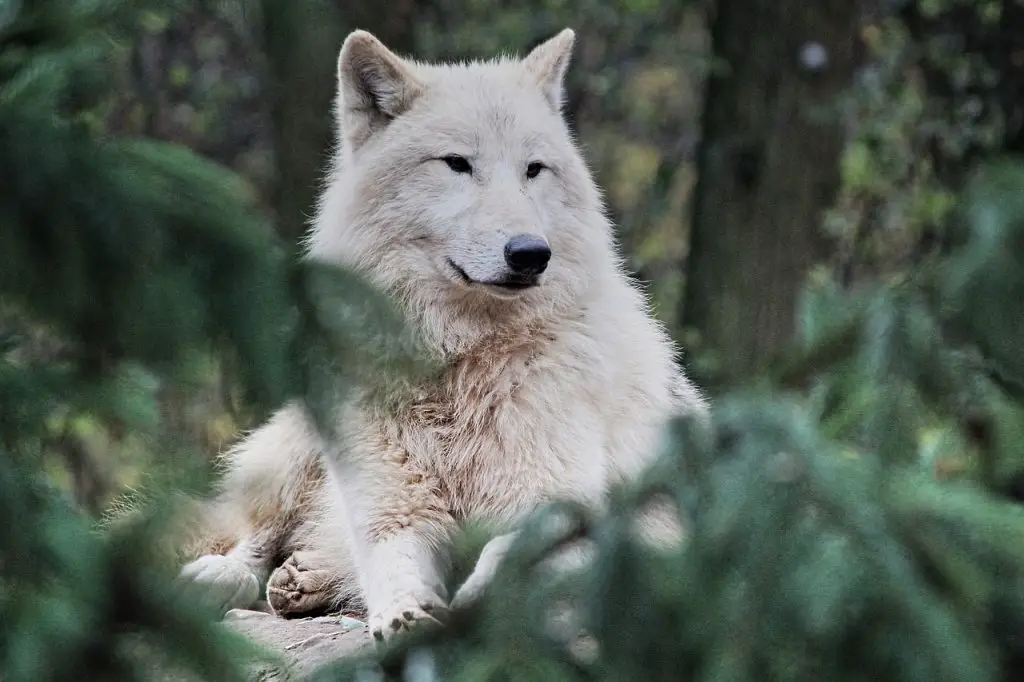
Arctic wolves (Canis lupus arctos) represent a sub-species of the grey wolf. The master of survival in an unforgiving place showcases a magnificent white coat perfectly adapted to its icy surroundings. In addition to camouflage, their fur provides effective insulation against the extreme cold, and their keen sense of smell and hearing aids in hunting prey such as muskoxen, Arctic hares, and caribou.
Arctic wolves often live in family packs, where cooperative hunting and a well-defined social structure contribute to their survival in harsh conditions.
White Pelicans
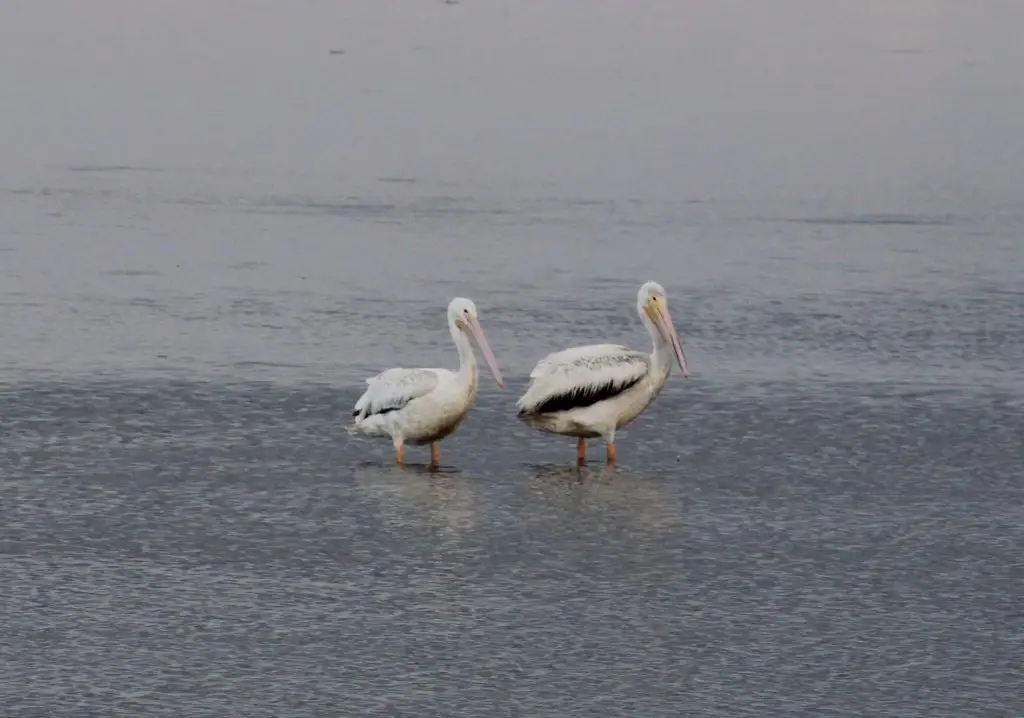
The white pelican (Pelecanus erythrorrhynchos) is an incredibly large bird. In fact, their wingspan can reach up to nine feet. The white coloration of these pelicans is prominent throughout their bodies, except for their striking black wingtips, visible when in flight.
Unlike the brown pelican, the white pelican does not dive for its food. Instead, it employs a cooperative feeding strategy, where groups of pelicans work together to corral with their large feet and catch fish in their pouched bills.
Many white pelicans breed in the northern parts of North America, specifically places like Jackson Hole, WY, during the summer and then migrate south to warmer regions for the winter. For example, I’ve seen them enjoying the warmer weather in both Everglades National Park and St. Marks Wildlife Refuge.
White Tiger
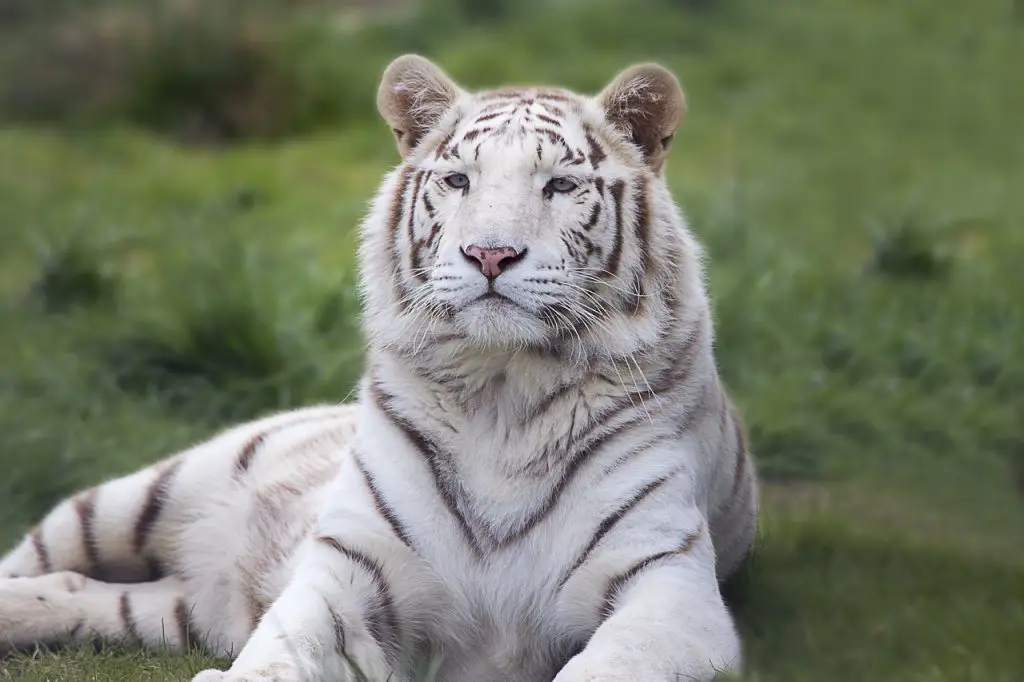
The white tiger is rare variant of the Bengal tiger. The distinct coloration is the result of a genetic condition known as leucism, which causes a reduction in pigmentation. White tigers carry the same characteristic stripes as their orange counterparts but with a lighter background.
While these majestic creatures often capture the imagination, it’s essential to note that their presence in the wild is extremely rare, and most white tigers in captivity are the result of selective breeding.
They are skilled hunters, relying on their strength, agility, and sharp claws and teeth to capture prey. Noteworthy is the controversy surrounding the breeding of white tigers in captivity, as it often involves inbreeding to maintain the desired coloration. This practice can lead to various health issues and raises ethical concerns within the conservation community.
Ermine
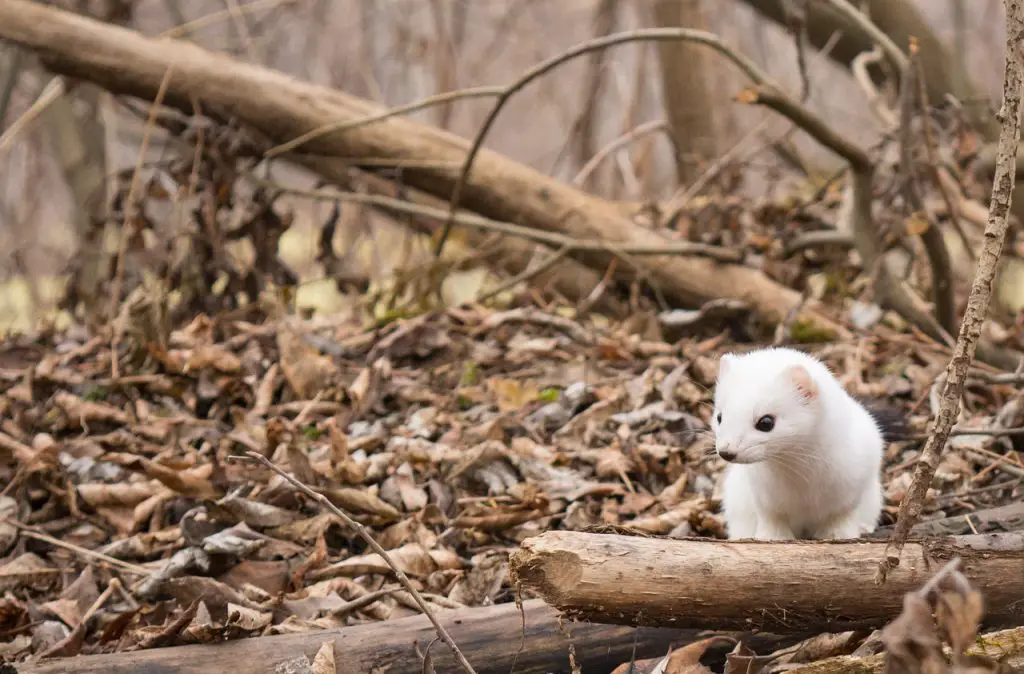
The ermine, scientifically known as Mustela erminea, is a small carnivore known for its remarkable coat changes with the seasons. In their winter fur, ermines display a pristine white coat, which serves as effective camouflage against snowy landscapes. This seasonal color adaptation is not only for concealment but also helps them maintain thermal insulation in colder climates.
During the warmer months, their fur transitions to a brown color with a white belly, allowing them to blend seamlessly with their surroundings. Their small size, reaching about 7 to 13 inches in length, makes them agile hunters in pursuit of small mammals and birds.
Arctic Fox
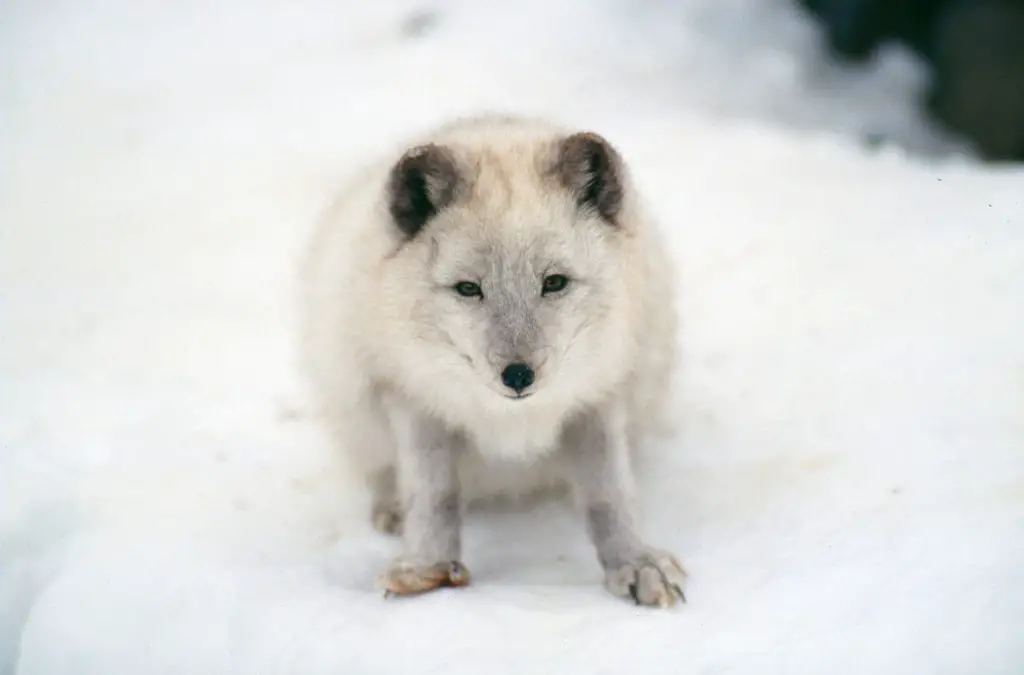
The Arctic fox (Vulpes lagopus) live in the Arctic tundra.
In the winter months, the fox dons an exquisite white coat. As seasons change, the Arctic fox undergoes a molt, transitioning to a brown or grayish-brown fur in the summer, blending seamlessly with the exposed terrain.
Arctic foxes are resourceful critters and often follow polar bears to scavenge leftovers from their kills.
Beluga Whale
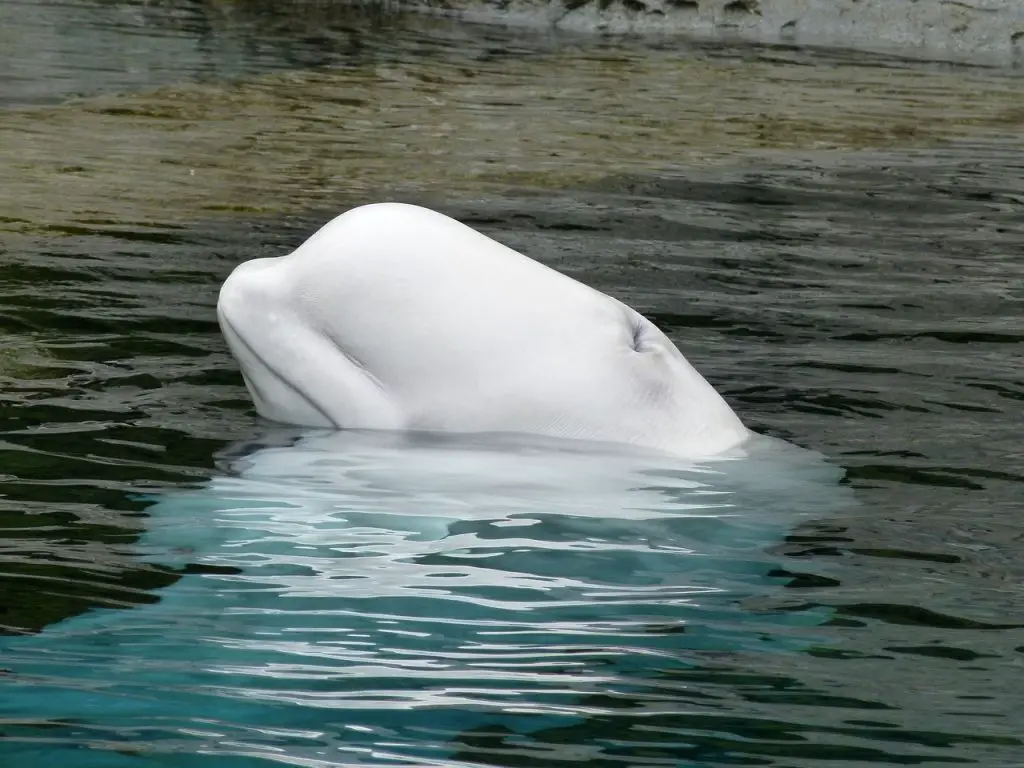
The beluga whale (Delphinapterus leucas), a charismatic marine mammal, is known for its distinctive pure white coloration, often described as the “canaries of the sea.”
The white coloration is not only an aesthetic feature but serves a functional purpose in their Arctic and subarctic environments. It provides effective camouflage in icy waters, aiding in their pursuit of prey, which primarily includes fish, squid, and crustaceans. Unlike other cetaceans, belugas are born gray or even brown and gradually lighten in color as they age, with adults displaying the characteristic white hue.
Beluga whales have a unique, bulbous forehead known as a melon, which allows them to manipulate their facial expressions and produce a variety of vocalizations. They are often found in pods and are sometimes willing to interact with humans.
Silkie Chicken
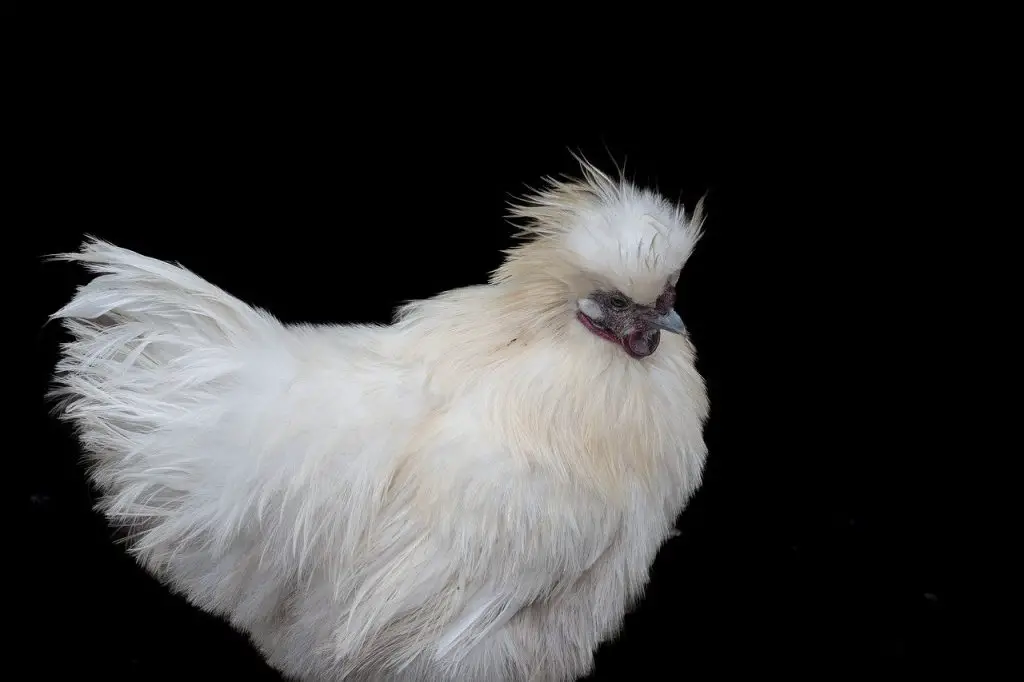
Silkie chickens are an ornamental poultry breed. While Silkies can come in various colors, including black, blue, and buff, the white variant is particularly prized for its elegant and pristine appearance.
White-Tailed Ptarmigan

The White-Tailed Ptarmigan, scientifically known as Lagopus leucura, is a master of seasonal adaptation in the high-altitude alpine regions of North America. This captivating bird undergoes a remarkable change in plumage, transitioning from brownish-gray in the summer to a pristine white during the winter months, effectively camouflaging itself against the snow-covered landscapes.
Despite their seemingly well-camouflaged appearance, these birds are skilled and agile fliers, taking to the air when threatened.
White Dove

White doves hold cultural significance and symbolism in various societies, often representing peace and purity. Unlike some other white animals that adopt their coloration for adaptive purposes, white doves are the result of selective breeding for specific traits. Their pristine white feathers symbolize innocence and have made them popular choices for ceremonial releases during weddings and other special events.
Most white doves have a strong homing instinct, allowing them to navigate long distances and return to their place of origin.
The Mute Swan
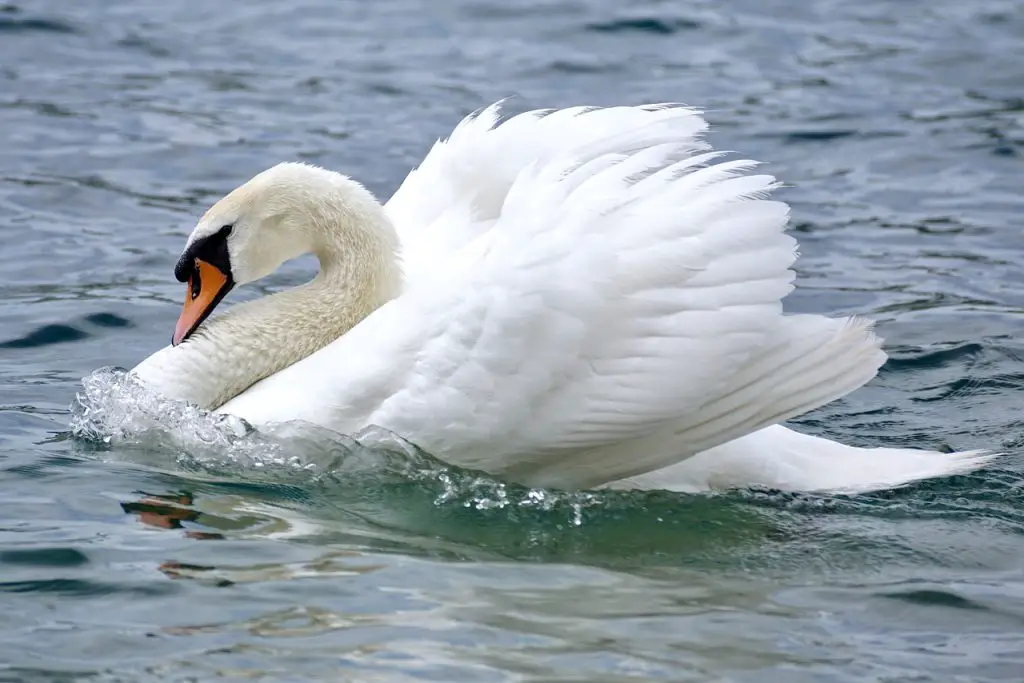
The Mute Swan (Cygnus olor) is one of the most iconic white swan species, recognized for its striking all-white plumage and distinctive orange bill.
Swans tend to exhibit grace and beauty in their courtship displays, where they engage in synchronized swimming and elaborate head movements. Swans are known for forming strong and lasting pair bonds, often staying with the same mate for life.
White Ravens

The white raven is a rare and captivating variation of the common raven found in various mythologies and folklore. Unlike the typical glossy black plumage of its counterparts, the white coloration in ravens is often attributed to a genetic condition called leucism, which results in a partial loss of pigmentation.
This unique coloration, while not as adaptive for camouflage, has made white ravens symbolic in cultural narratives, often representing mystery or omens in different societies.
Kermode Bears
The Kermode bear, scientifically known as Ursus americanus kermodei, is a rare and enchanting subspecies of the American black bear found primarily in the coastal rainforests of British Columbia, Canada. Commonly referred to as the “spirit bear” or “ghost bear,” the Kermode bear is known for its unique white or cream-colored fur. The distinctive coloration is not due to albinism but is a result of a recessive gene, making these bears an intriguing example of a natural variation within a species.
Kermode bears resemble other American black bears, with a stocky build, round face, and sharp claws. Despite their white fur, not all Kermode bears are completely devoid of pigment, as some may have a slight coloration on their paws or faces.
These unique bears hold cultural significance to the indigenous peoples of the region, with the spirit bear being considered a symbol of peace and harmony.
Albino Alligators
The albino alligator is a rare phenomenon in the reptile world. These alligators exhibit a lack of melanin, the pigment responsible for coloration, resulting in a striking white or cream-colored appearance.
Albino alligators stand out prominently in their habitats, presenting a stark contrast to their normally pigmented counterparts. The lack of melanin also affects their eyes, which appear pink or red due to the absence of pigments that typically provide coloration.
In the wild, their lack of color makes them more susceptible to predation. Due to their unique appearance and vulnerability to predators in the wild, albino alligators are often found in captivity, showcased in zoos and wildlife facilities.
Camargue Horse
The Camargue horse is an ancient breed native to the marshes of the Camargue region in southern France. Renowned for their distinctive white coat, these horses are not albinos, but rather their coloration is attributed to a genetic adaptation that lightens their coats.
Camargue horses are born with a dark coat, which gradually lightens as they age, culminating in their characteristic white appearance. Their unique coloration provides them with effective camouflage in the marshlands, helping them avoid predators and facilitating their survival in this unique environment.
Dall’s Sheep
Dall’s sheep, scientifically known as Ovis dalli, are majestic wild sheep native to the mountainous regions of North America, particularly found in Alaska, the Yukon, and parts of western Canada. Their striking white coloration is a key adaptation to their alpine habitat, providing effective camouflage against the snowy landscape. Dall’s sheep exhibit sexual dimorphism in their coat color, with males, or rams, typically displaying a white coat, while females, or ewes, may have a mix of brown and white.
Their robust bodies, powerful legs, and concave hooves make them well-adapted to navigate the rugged and steep terrain of their mountainous habitat. Noteworthy is their agility and ability to traverse seemingly inaccessible cliffs and ledges with ease.
Snowy Owl

The Snowy Owl, scientifically known as Bubo scandiacus, is a bird species inhabiting the Arctic tundra and other northern regions. Renowned for its pristine white plumage, the Snowy Owl’s coloration serves as effective camouflage in the snowy landscapes it calls home. Unlike some other white animals that exhibit color changes with seasons, the Snowy Owl maintains its white feathers throughout the year, blending seamlessly with the icy environment.
These owls are known for their adaptability in hunting. They primarily prey on lemmings and other small mammals but also capable of taking down larger birds. Snowy Owls are also recognized for their nomadic behavior, with some individuals migrating southward in response to varying prey availability.
Harp Seal Pup
Harp Seal pups are born with a soft, pristine white fur coat. It provides them with effective insulation against the harsh Arctic environment and serves as a natural camouflage on the ice. This white coloration allows them to blend seamlessly with the snow-covered ice floes, providing protection from predators such as polar bears and Arctic foxes.
The white coat of the pup gradually molts into a silvery-gray color as it matures.
White Tern
The White Tern (Gygis alba) is a graceful seabird found in tropical and subtropical regions around the world. As the name suggests, these terns exhibit a predominantly white plumage, with long, slender wings and a deeply forked tail. Their striking white coloration serves multiple purposes, including camouflage against the bright sky when viewed from below.
These birds often nest on small branches, ledges, or even man-made structures rather than constructing traditional nests. Their single white egg is incubated by both parents. Once hatched, the chick is cared for intensively until it is ready to fledge.
Ivory Gull
The Ivory Gull (Pagophila eburnea) is an Arctic bird that stands out for its pristine all-white plumage. The ivory gull’s white coloration provides effective camouflage against the icy landscapes it calls home. Unlike some other white animals that undergo seasonal changes in color, the ivory gull maintains its snowy appearance year-round.
Snow Petrels
The Snow Petrel (Pagodroma nivea) is an elegant seabird that calls the frigid and pristine Antarctic environment its home. The white coloration aids in concealment from predators. It also serves as a reflective layer, helping the birds regulate their body temperature in the extreme Antarctic conditions.
Frequently Asked Questions: White Animals
What are all white animals called?
White animals that are missing all of their pigmentations are often called albino animals.
What is a rare white animal?
Kermode bears, also known as the “spirit bears” and albino alligators are especially rate white animals.
What color is albino?
Albino individuals lack pigmentation, which gives them a characteristic white or pale appearance. Albino animals often exhibit a lack of melanin, the pigment responsible for coloration in skin, fur, feathers, or scales. The eyes of albino animals may appear red or pink due to the absence of pigments in the iris, allowing the underlying blood vessels to show through.
